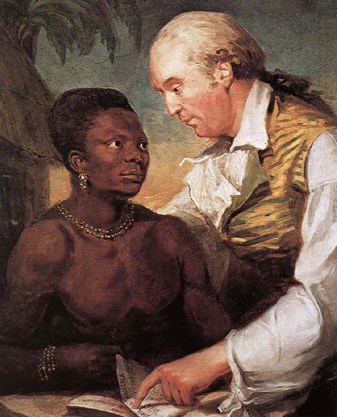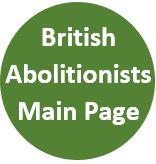Carl Bernhard Wadström (1746-1799)
By Robert William Rix

Biography
Carl Bernhard Wadström, although Swedish, was a central figure in the British abolition movement. He was born in Stockholm in 1746. He established a society in Norköpping, Sweden, in 1779, which worked to establish a colony in Africa built on agricultural trade as an alternative to slavery. This was continued by the Exegetical and Philanthropic Society, which Wadström co-founded in 1786.The anti-slavery programmes pursued by the societies were partly predicated on central tenets in the writings of the Swedish mystic and seer Emanuel Swedenborg (1688-1772). Swedenborg held the belief that the "African race" was "in greater enlightenment than others on this earth, since they are such that they think more interiorly, and so receive truths and acknowledge them" (A Treatise concerning the Last Judgment, n. 118). Swedenborg had further declared that there existed a hidden African Church, whose members apprehended unmediated truth. These ideas provided intellectual fuel for the abolitionist cause and compelled several Swedenborgians to travel to Africa.
In 1787, the Swedish King Gustaf III subsidised a venture to establish a West African colony, which would blend investment with philanthropy by trading with the Africans. Wadström was sent as the head of an expedition to Guinea to find a suitable location. In the colonies he visited, he saw evidence of the brutality of the slave trade.
In 1788, Wadström relocated to England, where he established contact with leading abolitionists Thomas Clarkson, Granville Sharp and William Wilberforce. In London, he published Observations on the Slave Trade, and a Description of some part of the Coast of Guinea (1789) with the purpose of "exposing to the world the atrocious acts committed in that part of the globe to which I have been eye-witness" ("Preface," viii). The work excited much interest in the abolitionist cause. Wilberforce drew upon Wadström's information in his speeches, and the he was invited to give his eyewitness account before the Privy Council and a Committee of the whole House of Commons in 1789, 1790, and 1791.
Wadström published several engravings of slave ships and the inhumane conditions of the Africans, which proved to be a remarkably influential means of raising awareness for the abolitionist cause. Clarkson ordered 500 copies of one of these engravings to be distributed among influential people when he went to Paris in 1789 for the purpose of canvassing French support for abolition.
Wadström was baptised into the Swedenborgian New Jerusalem Church in Great Eastcheap, London, on Christmas day 1788. With other Swedenborgians, he signed a proposed constitution for a colony in Sierra Leone, which was to be run in accordance with Swedenborgian doctrines. This was published as A Plan for a Free Community upon the Coast of Africa under the Protection of Great Britain; but Intirely Independent of All European Laws and Governments (1789). Central to the argument here was the eventual abolition of slavery.
The same year, the poet and painter William Blake, who signed his name in support of the London New Jerusalem Church, engraved the poem "The Little Black Boy". Like Blake, Wadström entertained politically radical sympathies. He combined his interests in Swedenborg and abolitionist activity with frequent visits to the reformist Manchester Constitutional Society.
Baptised into the New Jerusalem Church with Wadström was the black youth Peter Panah, the son to the king of Mezurado, who had been sold to slavery in Sierra Leone, but was bought free and brought to England by Wadström. Panah was placed in a boarding school to be taught the basic principles of Christianity. He died from consumption in Wadström's home in October 1790.
Wadström's most famous work was his two-part abolitionist classic An Essay on Colonization, particularly applied to the Western Coast of Africa, with some Free Thoughts on Cultivation and Commerce (1794-95), which contained several elegantly engraved plates and fold-out maps, including the now often reprinted cross-section of a typical slave ship. In this, Wadström not only exposed the cruelties of slavery, but he also appealed to Western economical rationalism by arguing that the slave trade had impeded the benefits of colonisation: the Africans were worth much more as trading partners and wage labourers than as slaves. The Essay made Wadström one of the leading voices of abolitionism in Britain and won much recognition around Europe. It was translated into German in 1796 and into French in 1798. Fellow abolitionist Dr William Gibson (author of Mitigation of Slavery [1814]) later claimed that he had supplied both material and style for the Essay while Wadström pursued fantastic theories.
Having lost considerable sums on a cotton factory in Manchester, Wadström relocated to Paris in 1795. His reputation as a significant abolitionist travelled with him, and he was made honorary citizen. The same year, he published Adresse au Corps Législatif et au Directoire Exécutif de la République Francaise, in which he called upon the Directory to make common cause with Britain to abolish all slavery. In France, he found high favour with Napoleon (who borrowed his Essay to take with him on his journey to Egypt) and the Directory. In 1797, he became a leading member of the French abolition society, Les Amis de Noir et des Colonies. He called the world's first conference on the colonial question in 1799. The same year, Wadström died from an asthmatic complaint and was given a French state funeral with ceremonial honours.
© Robert W. Rix, 2004
Bibliography
Selected Works
- Observations on the Slave Trade, and a Description of some Part of the Coast of Guinea, during a Voyage in 1787 and 1788, in company with Dr. A. Sparrman and Capt. Arrehenius (London: printed and sold by James Phillips, 1789)
- Plan for a Free Community upon the Coast of Africa under the Protection of Great Britain; but Intirely Independent of All European Laws and Governments (London: Robert Hindmarsh, 1789). Signed by Wadström and other Swedenborgians, but probably written by August Nordenskjöld. Republished in 1792 as Plan for a Free Community at Sierra Leona, upon the coast of Africa, under the protection of Great Britain; with an invitation to all persons desirous of partaking the benefits thereof (London: T. and J. Egerton).
- An Essay on Colonization Particularly Applied to the Western Coast of Africa with Some Free Thoughts on Cultivation and Commerce (London: Darton and Harvey, 1794-95)
- Adresse au Corps Législatif et au Directoire Executif de la République Francaise [concerning the colonies of Sierra Leona and Bulama] (Paris: n.p., 1795)
- La Réunion des Amis des Noirs et des Colonies ayant remis au cit. Wadstrom une esquisse des règlemens, etc [proposed articles of rules of the society] (Paris: n.p., 1798)
Selected Works in Facsimile
- Carl Bernhard Wadström, An Essay on Colonization particularly applied to the Western Coast of Africa (Newton Abbot: David & Charles, 1968).
Secondary Works
- Abridgment of the Minutes of the Evidence taken before a Committee of the Whole House, to whom it was referred to consider of the Slave Trade, 1789, 1790, 1791 (London: n.p., 1792?).
- Christopher Fyfe, A History of Sierra Leone (Aldershot: Gregg Revivals, 1993), 42-43.
- Coleman, Dierdre, 'Conspicuous Consumption: White Abolitionism and English Women's Protest Writing in the 1790s', ELH, 61 (1994), 341-362
- Ellen Hagen, En frihetstidens son: Carl Bernhard Wadström (Stockholm: Gothia Aktiebolag, 1946).
- Philip K. Nelson, Carl Bernhard Wadström: Mannen bakom myten (Norrköping: Foreningen Gamla Norköpping, 1998).
- Morton D. Paley, "A New Heaven Is Begun: Blake and Swedenborgianism," Blake: An Illustrated Quarterly 13 (1979): 64-90.
- Rudolph L. Tafel (ed.), Documents Concerning the Life and Character of Emanuel Swedenborg, 2 vols. (London: Swedenborg Society, 1875-1877), 1:644-47.
- Robert W. Rix, "William Blake and Radical Swedenborgianism," Esoterica 5 (2003), 73-94.
Read online
Links



